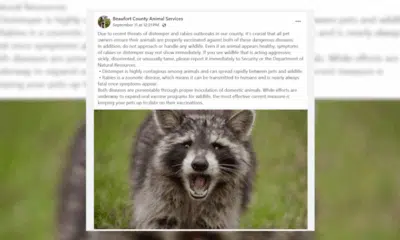News from the South - Missouri News Feed
FDA seeks to phase out 8 common food dyes
by Jennifer Shutt, Missouri Independent
April 23, 2025
WASHINGTON — Trump administration health officials announced Tuesday they hope to eliminate eight petroleum-based synthetic dyes from the nation’s food supply before the end of next year, though they haven’t received guarantees or written agreement from food companies.
Food and Drug Administration Commissioner Marty Makary detailed efforts to phase out the dyes during a press conference alongside Health and Human Services Secretary Robert F. Kennedy Jr. at the department’s Washington, D.C., headquarters.
“Let’s be honest, taking petroleum-based food dyes out of the food supply is not a silver bullet that will instantly make America’s children healthy, but it is one important step,” Makary said.
The FDA’s proposal would revoke authorization for Citrus Red No. 2 and Orange B while setting up the agency to work “with industry to eliminate” Green No. 3, Red No. 40, Yellow No. 5, Yellow No. 6, Blue No. 1 and Blue No. 2.
FDA will also authorize new, natural food dyes in the months ahead.
Kennedy said the Trump administration has an “understanding,” but not an “agreement” with food companies that use the dyes, before deferring to Makary, who said that “you win more bees with honey than fire.”
“There are a number of tools at our disposal. And so I believe in love, and let’s start in a friendly way and see if we can do this without any statutory or regulatory changes,” Makary said. “But we are exploring every tool in the toolbox to make sure this gets done very quickly. And they want to do it. They want to do it.
“So why go down a complicated road with Congress when they want to do this? They don’t want to deal with the patchwork of 30 different state plans.”
Christopher Gindlesperger, senior vice president of public affairs and communications at the National Confectioners Association, released a written statement that didn’t appear to agree entirely with the FDA’s proposed phase-out, however.
“FDA and regulatory bodies around the world have deemed our products and ingredients safe, and we look forward to working with the Trump Administration and Congress on this issue,” Gindlesperger wrote. “We are in firm agreement that science-based evaluation of food additives will help eliminate consumer confusion and rebuild trust in our national food safety system.”
Removing additives
During the press conference, Makary held up watermelon, beet and carrot juices in clear containers, encouraging food companies to use those as dye, instead of the ones that may be removed from the market.
“We are simply asking American food companies to replace petroleum-based food dyes with natural ingredients for American children, just as they already do for children in other countries,” he said. “American children deserve good health.”
Makary said he believes there are several health conditions associated with petroleum-based synthetic dyes in food, including attention-deficit/hyperactivity disorder, obesity, diabetes, insulin resistance, cancer, genomic disruption, gastrointestinal issues, and allergic reactions.
Kennedy said his goal as HHS secretary is to remove all additives in food served in schools “that we can legally address.”
The department, Kenedy said, will also work with Congress and President Donald Trump to increase labeling for food ingredients that Kennedy called addictive, including sugar.
“There’s things that we’ll never be able to eliminate, like sugar. And sugar is poison and Americans need to know that,” Kennedy said. “It is poisoning us. Is giving us a diabetes crisis.”
Health effects unclear
Martin Bucknavage, senior food safety extension associate at Penn State University, said during an interview with States Newsroom that petroleum-based synthetic food dyes are derived just to get the color.
“It’s not like it’s just a nasty chemical that they’re putting in there,” he said. “It’s something that’s been taken, it’s been chemically made, modified and then purified, so that it is just that chemical that provides that color. And then those colors have been studied.”
Similar to the complicated nature of nutrition studies — which can have a challenging time separating out a person’s genetics, exercise and environmental factors from one specific part of their diet — research on food dyes hasn’t been conclusive, Bucknavage said.
“In some cases, it does have an impact on hypersensitivity, but not in all cases,” he said. “And not all studies are basically showing the same thing. So there’s a lot of variability that exists out there.
“And I’m not saying, ‘Listen, we shouldn’t go through and study these things more and get better information on them.’ We certainly should. But again, it’s not an easy thing to do. Some of these studies take time and take a lot of money and sometimes the results are kind … more variable in terms of the results.”
States regulating dyes
The FDA’s announcement wasn’t the first time the federal government or state lawmakers have sought to ban food additives or synthetic dyes.
The Biden administration announced in January that the federal government would ban Red No. 3 in food beginning in 2027 and from medicines in 2028. Makary said during the press conference Tuesday the current administration plans to ask companies to phase out that dye sooner.
California lawmakers approved a bill in 2023 that will ban Red No. 3, propylparaben, brominated vegetable oil and potassium bromate from food starting in 2027.
The following year, legislators in the Golden State approved another measure that, starting in 2028, will ban six food dyes — Blue 1, Blue 2, Green 3, Red 40, Yellow 5 and Yellow 6 — from being sold in schools.
Those two state laws followed the California Environmental Protection Agency’s Office of Environmental Health Hazard Assessment releasing a report in 2021 that concluded “scientific literature indicates that synthetic food dyes can impact neurobehavior in some children.”
Virginia lawmakers approved legislation earlier this year that Gov. Glenn Youngkin signed in March to ban some artificial food dyes in public schools, starting in July 2027.
In deeply red West Virginia, Republican Gov. Patrick Morrisey signed a bill a few days later that will prevent seven artificial dyes from being sold in grocery stores starting in 2028 or included in school lunches starting in August.
Arizona and Utah have implemented laws of their own addressing food dyes.
The Environmental Working Group, an advocacy organization focused on strengthening health standards, reports that legislators in several states, including Arkansas, Florida, Indiana, Iowa, Kentucky, Louisiana, Maryland, Minnesota, Missouri, New Jersey, New Mexico, North Carolina, Oklahoma, Oregon, Pennsylvania, Rhode Island and Washington have introduced bills that could ban certain food dyes or chemicals.
Melanie Benesh, EWG vice president for government affairs, wrote in a statement about the FDA announcement that the federal agency “has known for decades that synthetic food dyes are linked to health problems, particularly in children, but has failed to act.”
“We’re pleased the administration is following the lead of states like California and West Virginia by finally announcing their intent to ban dyes,” Benesh wrote. “We’re grateful that states like California and West Virginia have forced the FDA to make food safety a bigger priority.”
Peter Lurie, president and executive director of the self-described food and health watchdog group Center for Science in the Public Interest, wrote in a statement released Monday that Americans “don’t need synthetic dyes in the food supply, and no one will be harmed by their absence.”
“The most important thing to know about food dyes is that their only purpose is to make food companies money,” Lurie wrote. “They are purely cosmetic, serving no nutritional function. In other words, food dyes help make ultra-processed foods more attractive, especially to children, often by masking the absence of a colorful ingredient, like fruit.”
Ashley Murray contributed to this report.
Missouri Independent is part of States Newsroom, a nonprofit news network supported by grants and a coalition of donors as a 501c(3) public charity. Missouri Independent maintains editorial independence. Contact Editor Jason Hancock for questions: info@missouriindependent.com.
The post FDA seeks to phase out 8 common food dyes appeared first on missouriindependent.com
Note: The following A.I. based commentary is not part of the original article, reproduced above, but is offered in the hopes that it will promote greater media literacy and critical thinking, by making any potential bias more visible to the reader –Staff Editor.
Political Bias Rating: Center-Left
The content reflects a Center-Left bias primarily through its focus on health regulations and food safety, aligning with progressive views on consumer protection and public health. It discusses the government’s intent to phase out synthetic food dyes in favor of natural alternatives, which is a policy that resonates with findings from health advocacy groups and studies highlighting potential health concerns associated with such additives.
Furthermore, it features quotes from officials like Health and Human Services Secretary Robert F. Kennedy Jr., who expresses a commitment to banning harmful additives, which indicates a proactive stance on health issues often associated with left-leaning policy agendas. Additionally, the piece includes perspectives from advocacy organizations critical of the status quo, reinforcing a narrative that advocates for stronger health regulations, a hallmark of Center-Left politics.
While the reporting doesn’t exhibit overt partisanship, it does reflect a preference for government intervention in health matters, a characteristic often associated with more liberal political viewpoints.
News from the South - Missouri News Feed
Luke Altmyer scores 3 TDs, No. 9 Illinois shuts out Western Michigan, 38-0
SUMMARY: No. 9 Illinois defeated Western Michigan 38-0, extending its winning streak to seven games, the longest since 2011. Quarterback Luke Altmyer threw two touchdowns and ran for another, while Kaden Feagin rushed for 100 yards and a touchdown. Illinois’ defense made critical stops, preserving the shutout despite only leading 10-0 at halftime. Coach Bret Bielema expressed frustration at the team’s slow start. Illinois remains turnover-free this season and has outscored opponents 128-22 in three games. Their next challenge is Big Ten play against No. 22 Indiana. Western Michigan starts MAC play next week against Toledo.
The post Luke Altmyer scores 3 TDs, No. 9 Illinois shuts out Western Michigan, 38-0 appeared first on fox2now.com
News from the South - Missouri News Feed
Panic and chaos at a St. Louis area mall false reports of shots fired
SUMMARY: Panic erupted at West County Center mall in the St. Louis area Saturday around 2:30 p.m. after a false report of shots fired in the food court. Police arrived quickly but found no active shooter. The confusion stemmed from a fight where a chair was thrown, causing fear among shoppers. Maya Emig, separated from her family, was comforted by strangers during the chaos. Traffic snarled as parents tried to reach their children. The incident, amid recent nationwide gun violence, heightened fears but no arrests were made. Authorities confirmed no guns were involved and no charges will be filed.
A fight near the food court where a chair was thrown at a victim caused some confusion, which then turned into panic and chaos amid rumors of an active shooter.
News from the South - Missouri News Feed
UTVs, ROVs may soon be allowed on Wentzville streets
SUMMARY: Wentzville’s Board of Aldermen voted 4-2 to allow utility terrain vehicles (UTVs) and recreational off-highway vehicles (ROVs) on city streets under conditions similar to golf cart rules. Use would be limited to subdivisions with speed limits of 25 mph or less, requiring valid licenses, insurance, and safety features. However, Mayor Nick Guccione vetoed the ordinance, citing safety and enforcement concerns, supported by residents and officials. The Board may override the veto on September 24. Supporters emphasize personal responsibility, while opponents worry about public safety. Enforcement challenges exist, especially regarding underage drivers. Missouri law permits municipalities to regulate such vehicles locally.
Read the full article
The post UTVs, ROVs may soon be allowed on Wentzville streets appeared first on fox2now.com
-
News from the South - North Carolina News Feed6 days ago
What we know about Charlie Kirk shooting suspect, how he was caught
-
Local News7 days ago
Russian drone incursion in Poland prompts NATO leaders to take stock of bigger threats
-
News from the South - North Carolina News Feed6 days ago
Federal hate crime charge sought in Charlotte stabbing | North Carolina
-
Our Mississippi Home5 days ago
Screech Owls – Small but Cute
-
News from the South - Arkansas News Feed6 days ago
NW Arkansas Championship expected to bring money to Rogers
-
News from the South - North Carolina News Feed6 days ago
Under pressure, some immigrants are leaving American dreams behind
-
News from the South - Alabama News Feed7 days ago
Huntsville Fire & Rescue Holds 9/11 Memorial Service | Sept. 11, 2025 | News 19 at 5 p.m.
-
News from the South - Texas News Feed6 days ago
Safe Central Texas meet-up spots for online purchases
















































